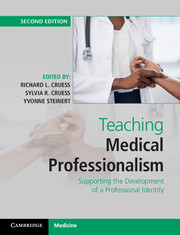Book contents
- Frontmatter
- Contents
- List of contributors
- Foreword
- Introduction
- Part I What is to be taught and learned
- Part II Theory
- Part III Principles
- 8 General principles for establishing programs to support professionalism and professional identity formation at the undergraduate and postgraduate levels
- 9 Faculty development to support professionalism and professional identity formation
- 10 Becoming interprofessional: professional identity formation in the health professions
- 11 Assessment of professionalism and progress in the development of a professional identity
- 12 Remediation of unprofessional behavior
- 13 Professional identity formation, the practicing physician, and continuing professional development
- 14 Professionalism, professional identity, and licensing and accrediting bodies
- Part IV Case studies in promoting professionalism and professional identity formation across the continuum
- Part V The future
- Index
- References
12 - Remediation of unprofessional behavior
from Part III - Principles
Published online by Cambridge University Press: 05 April 2016
- Frontmatter
- Contents
- List of contributors
- Foreword
- Introduction
- Part I What is to be taught and learned
- Part II Theory
- Part III Principles
- 8 General principles for establishing programs to support professionalism and professional identity formation at the undergraduate and postgraduate levels
- 9 Faculty development to support professionalism and professional identity formation
- 10 Becoming interprofessional: professional identity formation in the health professions
- 11 Assessment of professionalism and progress in the development of a professional identity
- 12 Remediation of unprofessional behavior
- 13 Professional identity formation, the practicing physician, and continuing professional development
- 14 Professionalism, professional identity, and licensing and accrediting bodies
- Part IV Case studies in promoting professionalism and professional identity formation across the continuum
- Part V The future
- Index
- References
Summary
Around the time of publication of the book Teaching Medical Professionalism,1 literature on remediation of unprofessional behavior of learners and practitioners in medicine had just begun to emerge in earnest, no doubt reflecting developments in accreditation of graduate medical education programs and health facilities as well as concern for patient safety. The book's chapter on the topic2 summarized the extant publications, along with the authors’ experience in addressing professional lapses of learners in academic medicine. Much of the work covered in the chapter provided prescriptions for how to proceed with the process of remediation: general approaches to remediation, policies to follow, steps to take including the development of a detailed remediation plan, and suggestions for specific remediation techniques. Apparent themes emphasized changing the behavior of the individual learner or practitioner and the crucial role of assessment in identifying and defining a lapse, as well as determining whether remediation had been successful. Factors thought to predict success or failure of the attempt to correct unprofessional behavior were proposed, including the individual's recognition that a problem exists, her subscription to the values of medical professionalism, a genuine desire to change her behavior, acceptance of the responsibility to participate in remediation, and her demonstration of accountability during the process.2 Program factors predictive of remediation success included early recognition of the problem, creation of a remediation plan with transparent goals, specific remediation activities, and frequent performance feedback under the guidance of a mentor–advisor who models professional behavior, administers the plan consistently, and in fact gives frequent feedback.2 Despite the existence of this wisdom from experts, there was recognition that remediation of unprofessional behavior was challenging and not always successful, with the likelihood of relapses and outright failures.
In the years since publication of Teaching Medical Professionalism to the present, the remediation literature has grown substantially. An emphasis on steps in the remediation process and techniques to address unprofessional behavior remains,3–21 while recognition of the relationship between professional lapses and patient safety has grown.9,16,18,22–25 Appreciation of the role of the environment has intensified, and specific recommendations for building environments supportive of effective remediation as well as professionalism have been formulated.9,15–18,25–28 Attention paid to the interaction between the environment and the individual in causing, addressing, and preventing unprofessional behavior has emerged.
- Type
- Chapter
- Information
- Teaching Medical ProfessionalismSupporting the Development of a Professional Identity, pp. 169 - 185Publisher: Cambridge University PressPrint publication year: 2016
References
- 4
- Cited by



